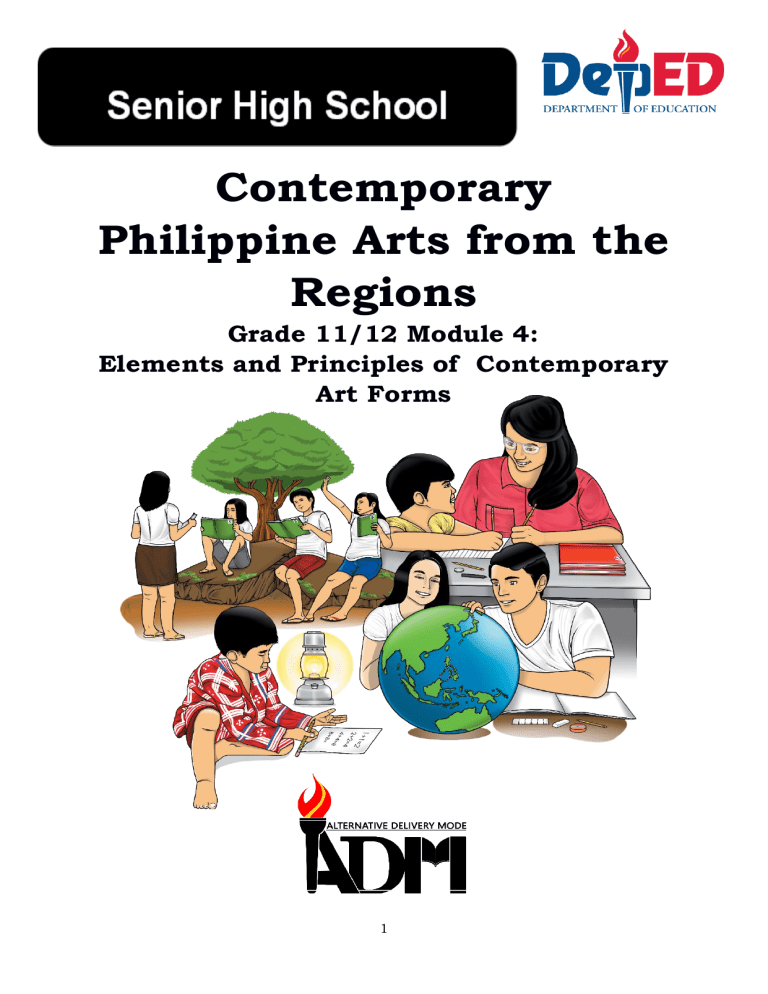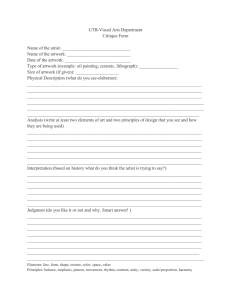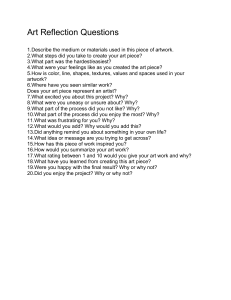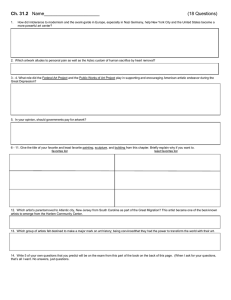
Contemporary Philippine Arts from the Regions Grade 11/12 Module 4: Elements and Principles of Contemporary Art Forms 1 CPAR – Grade 11-12 Alternative Delivery Mode Module 4: Elements and Principles of Contemporary Art Forms First Edition, 2020 Republic Act 8293, section 176 states that: No copyright shall subsist in any work of the Government of the Philippines. However, prior approval of the government agency or office wherein the work is created shall be necessary for exploitation of such work for profit. Such agency or office may, among other things, impose as a condition the payment of royalties. Borrowed materials (i.e., songs, stories, poems, pictures, photos, brand names, trademarks, etc.) included in this module are owned by their respective copyright holders. Every effort has been exerted to locate and seek permission to use these materials from their respective copyright owners. The publisher and authors do not represent nor claim ownership over them. Published by the Department of Education Secretary: Leonor Magtolis Briones Undersecretary: Diosdado M. San Antonio Development Team of the Module Writers: Herwin S. Gatdula Editors: Mrs. Amalia T. Solis, EPS Content Reviewer: Herwin S. Gatdula Language Reviewer: Fatima Vergara Illustrator: Name Layout Artist: Name Management Team: Malcolm S. Garma, Regional Director Genia V. Santos, CLMD Chief Dennis M. Mendoza, Regional EPS in Charge of LRMS and Regional ADM Coordinator Maria Magdalena M. Lim, CESO V, Schools Division Aida H. Rondilla, CID Chief Lucky S. Carpio, Division EPS in Charge of LRMS and Division ADM Coordinator Printed in the Philippines by ________________________ Department of Education – Region NCR Office Address: Telefax: E-mail Address: ____________________________________________ ____________________________________________ ____________________________________________ ____________________________________________ 2 Superintendent SHS Contemporary Philippine Arts from the Regions Module 4: Elements and Principles of Contemporary Art Forms Introductory Message For the facilitator: Welcome to the Contemporary Philippine Arts from the Regions 11/12 Alternative Delivery Mode (ADM) Module on the Elements and Principles of Contemporary Art Forms This module was collaboratively designed, developed and reviewed by educators both from public and private institutions to assist you, the teacher or facilitator in helping the learners meet the standards set by the K to 12 Curriculum while overcoming their personal, social, and economic constraints in schooling. This learning resource hopes to engage the learners into guided and independent learning activities at their own pace and time. Furthermore, this also aims to help learners acquire the needed 21st century skills while taking into consideration their needs and circumstances. In addition to the material in the main text, you will also see this box in the body of the module: Notes to the Teacher As a facilitator you are expected to orient the learners on how to use this module. You also need to keep track of the learners' progress while allowing them to manage their own learning. Furthermore, you are expected to encourage and assist the learners as they do the tasks included in the module. For the learner: Welcome to the CPAR 11/12 Alternative Delivery Mode (ADM) Module on Elements and Principles of Contemporary Art Forms! The hand is one of the most symbolized part of the human body. It is often used to depict skill, action and purpose. Through our hands we may learn, create and accomplish. Hence, the hand in this learning resource signifies that you as a learner is capable and empowered to successfully achieve the relevant competencies and skills at your own pace and time. Your academic success lies in your own hands! This module was designed to provide you with fun and meaningful opportunities for guided and independent learning at your own pace and time. You will be 4 enabled to process the contents of the learning resource while being an active learner. This module has the following parts and corresponding icons: What I Need to Know 5 This will give you an idea of the skills or competencies you are expected to learn in the module. What I Know This part includes an activity that aims to check what you already know about the lesson to take. If you get all the answers correct (100%), you may decide to skip this module. What’s In This is a brief drill or review to help you link the current lesson with the previous one. What’s New In this portion, the new lesson will be introduced to you in various ways such as a story, a song, a poem, a problem opener, an activity or a situation. What is It This section provides a brief discussion of the lesson. This aims to help you discover and understand new concepts and skills. What’s More This comprises activities for independent practice to solidify your understanding and skills of the topic. You may check the answers to the exercises using the Answer Key at the end of the module. What I Have Learned This includes questions or blank sentence/paragraph to be filled in to process what you learned from the lesson. What I Can Do This section provides an activity which will help you transfer your new knowledge or skill into real life situations or concerns. Assessment This is a task which aims to evaluate your level of mastery in achieving the learning competency. Additional Activities In this portion, another activity will be given to you to enrich your knowledge or skill of the lesson learned. This also tends retention of learned concepts. Answer Key This contains answers to all activities in the module. At the end of this module you will also find: References This is a list of all sources used in developing this module. The following are some reminders in using this module: 1. Use the module with care. Do not put unnecessary mark/s on any part of the module. Use a separate sheet of paper in answering the exercises. 2. Don’t forget to answer What I Know before moving on to the other activities included in the module. 3. Read the instruction carefully before doing each task. 4. Observe honesty and integrity in doing the tasks and checking your answers. 5. Finish the task at hand before proceeding to the next. 6. Return this module to your teacher/facilitator once you are through with it. If you encounter any difficulty in answering the tasks in this module, do not hesitate to consult your teacher or facilitator. Always bear in mind that you are not alone. We hope that through this material, you will experience meaningful learning and gain deep understanding of the relevant competencies. You can do it! What I Need to Know This module was designed and written with you in mind. It is here to help you master the elements and principles of contemporary art forms. The scope of this module permits it to be used in many different learning situations. The language used recognizes the diverse vocabulary level of students. The lessons are arranged to follow the standard sequence of the course. But the order in which you read them can be changed to correspond with the textbook you are now using. The module is composed of one lesson, namely: Lesson 1 – Elements and Principles of Contemporary Art Forms A. Most Essential Learning Competency: Evaluates contemporary art forms based on the elements and principles After going through this module, you are expected to: B. Specific Objectives Cognitive Identify the elements and principles of contemporary art forms 6 Affective Appreciate the value of contemporary art forms’ elements and principles Psychomotor Present an art work using contemporary art forms elements and principles. What I Know I. Directions: Read and analyze each sentence. Encircle the letter of the best answer. 1. Which of the following is NOT an example of line? A. Dot B. Wavy C. Outline D. Perpendicular 2. Which among the given field of art contains an element of art? A. Painting B. Photography C. Sketch D. Sculpture 3. It is known as the quality of a surface or the way any work of art is represented. A. Space B. Texture C. Value D. Color 4. What is an element of art that can be defined by other elements of art? A. Texture B. Line C. Shape D. Form 5. It refers to the space around and between the subject matter. A. Negative B. Positive C. Flat Lesson 1 D.Neutral Elements and Principles of Contemporary Art Forms What makes an art work? To deeply understand one’s creation, we must be knowledgeable about the basic concepts of its elements and principles. Knowing these basic concepts can boost visual literacy. Artists make more powerful art works when they utilize the principles and elements of art. On the other hand, when viewers are more familiar with the elements and principles of art, they can be more aware of the details and can better appreciate arts. Below are the definitions of the inseparable concepts to further understand contemporary art works. ELEMENTS OF ART- Building blocks of an artwork, tools artist used in creating an artwork 7 PRINCIPLES OF ART- Arrangements of elements (building blocks) -The way an artist can organized the elements of art to create a wide range of effects. What’s In Direction: Compare and contrast National Artists to GAMABA Artists. Explain your reaction on how important these artists in Filipino art. (Critical Thinking, Character Building) 8 NATIONAL ARTISTS GAMABA ARTISTS Reaction & Insights Reaction & Insights What’s New Activity 1: Analyze the painting below then complete the graphic organizer by providing the best ideas. Cotopaxi,1862 Oil on canvas By: Frederic Edwin Church Describe the colors in this How do the colors in this artwork. artwork made you feel? 9 What color scheme did the artist use: complementary, analogous, warm, cool, etc.? What is It To deepen your understanding of any art form, carefully analyze the table below about the elements and principles of contemporary art: ELEMENTS OF CONTEMPORARY ARTS HIGHLIGHTS EXAMPLE 1. LINE defined as a mark that spans a distance between two points (or the path of a moving point), taking any form along the way. pertains to the use of various marks, outlines and implied lines in artwork and design, most often used to define shape in two dimensional work. that the viewer's eye takes as it follows shapes, colors, and form along a path, but may not be continuous or physically connected, such as the line created by a dancer's arms, torso, and legs when performing an arabesque. https://brebru.com/art/line.html https://www.moma.org/collection/works /78984 2. FORM forming of two or more shapes or as threedimensional shape (cube, pyramid, sphere, etc.). tone, texture and colour. Form is considered threedimensional showing height, width and depth. Examples of these are sculpture, theater play and figurines 10 https://www.boisestatepublicradio.org/pos t/meet-moshe-safdie-internationallyacclaimed-architect-designing-new-boiselibrary#stream/0 3. TEXTURE surface or the way any work of art is represented. Lines and shading can be used to create different textures as well. portraying certain fabrics, one needs to give the feeling of the right texture so that it closely resembles to what the artist is trying to convey. https://www.pinterest.ph/pin/211880357 439907592/ 4. SHAPE of areas in two dimensional space that can be defined by edges, setting one flat specific space apart from another. (e.g.: square, circle, triangle, hexagon, etc.) or organic (such as the shape of a puddle, blob, leaf, boomerang, etc.) in nature. other elements of art: Space, Line, Texture, Value, Color, Form. 11 https://www.pablopicasso.org/threemusicians.jsp 5. SPACE provided for a particular purpose. dimensions (length and width), such as a floor, or it may have three dimensions (length, width, and height). background, foreground and middle ground. Space refers to the distances or areas around, between or within components of a piece. http://www.picnicwit.com/literaturearts/art/john-sloans-south-beach-1905 Positive space refers to the space of a shape representing the subject matter. Negative space refers to the space around and between the subject matter. 6. COLOR of hue in artwork and design. colors (red, yellow, blue) which cannot be mixed in pigment from other hues, secondary colors (green, orange, purple) which are directly mixed from combinations of primary colors. primary and secondary colors create tertiary (and more) hues. references that add variations in value. 12 https://www.pinterest.com.au/pin/453878 468671882538 7. VALUE Value, or tone, refers to the use of light and dark, shade and highlight, in an artwork. Value is directly related to contrast. https://www.khanacademy.org/humanitie s/art-1010/american-art-towwii/symbolism-america/a/tanner-banjolesson PRINCIPLES OF DESIGNS 1. CONTRAST HIGHLIGHTS Contrast refers to the arrangement of opposite elements and effects. For example: light and dark colors, smooth and rough textures, large and small shapes. Contrast can be used to create variety, visual interest, and drama in an artwork. EXAMPLE Caravaggio, Crucifixion of St. Peter, 16 https://artclasscurator.com/principle s-of-design-examples/ 2. EMPHASIS Emphasis refers to the area of an artwork that dominates attention or draws interest. It is often the area a viewer looks first. Artists can create emphasis by contrasting the elements of art such as: color, shape, size and https://artclasscurator.com/principle s-of-design-examples/ dominance, detail, contrast and isolation 3. MOVEMENT Movement can be thought of in two ways – the first refers to how an artist depicts movement using the elements and principles of art. The 13 second way refers to the https://artclasscurator.com/principle s-of-design-examples/ visual flow of an artwork, indicated by the path a viewer’s eyes take as they look at the artwork. 4. RHYTHM 5. PROPORTION Rhythm is a principle of art that refers to the movement or action of a composition, usually achieved through repetition of lines, shapes, colors, and more. It creates a visual tempo in artworks and provides a path for the viewer’s eye to follow. Proportion is the size relationship between the various parts of an artwork. Artists can use scale and proportion to create sensations such as depth, realism, disorientation, and drama. https://artclasscurator.com/principle s-of-design-examples/ The human figure is scaled to appear larger than the city skyline. The proportions could indicate depth of perspective or could symbolize the relationship of laborers in building a city. https://artclasscurator.com/principle s-of-design-examples/ 6. BALANCE Balance refers to the distribution of visual weight in a composition. Each part of the composition works with https://artclasscurator.com/principle other parts of the s-of-design-examples/ composition to appear equal and harmonious in balance. 7. UNITY Unity, also known as harmony, refers to the cohesiveness of an artwork—how whole, 14 Unity is achieved through: • repetition • simplicity • harmony • contrast• theme consistent, and complete and variation • proximity • it appears. Unity is the continuity pleasing combination of elements to create a harmonious composition. 8. VARIETY Variety refers to the elements of a composition that differ from one another. Variety creates visual interest and energy https://artclasscurator.com/principle s-of-design-examples/ What’s More Activity 1. Discussion Questions (Critical Thinking) 1. How can you analyze a particular art work of an artist? How can you describe an artist's work using these elements and principles? __________________________________________________________________________________ __________________________________________________________________________________ __________________________________________________________________________________ __________________________________________________________________________________ __________________________________________________________________________________ 2. Give the importance of these elements and principles to you as an audience to one's artwork. __________________________________________________________________________________ __________________________________________________________________________________ __________________________________________________________________________________ __________________________________________________________________________________ __________________________________________________________________________________ 3. How will you show appreciation on a specific artwork through the use of its elements and principles? ___________________________________________________________________________ ___________________________________________________________________________ ___________________________________________________________________________ __________________________________________________________________________ 15 Activity 2: Think and Talk: Look at the art work below and analyze and answer the questions thoroughly. ( Tughra of Sultan Süleiman the Magnificent ca. 1555-60 https://artclasscurator.com/principles-of-design-examples/#Rhythm 1. What elements and principles did this artist use to create rhythm? 2. If this painting were a song, what would it sounds like? How do the lines, color, and rhythm create the song? 3. How does rhythm create mood or emotion in the artwork? Katsushika Hokusai Ejiri in Suruga Province 1830 1.How did this artist show movement? 2. Name two or more elements of art the artist utilized to create movement. 3. How does movement create mood or emotion in the artwork? 16 What I Have Learned Lesson Summary: Elements and Principles of Contemporary Arts Elements (7) Line Form Texture Shape Space Color Value Principles (8) Contrast Emphasis Movement Rhythm Proportion Balance Unity What I Can Do Let us DRAW Draw/Sketch a symbol using the elements and principles of arts (line, space, color and value only) to show your feelings after learning the topic. Write 5 to 10 sentences to explain the symbol you created. Ask suggestions from your family members. ___________________________________________________________________________ ___________________________________________________________________________ ___________________________________________________________________________ 17 Assessment Direction: Write the letter (in capital) of the best answer on the space provided. (Critical Thinking) _____1. It refers to where value is directly directed. A. Tone B. Shade C. Contrast D. Highlight _____2. It refers to the space around and between the subject matter A. Negative B. Positive C. Flat D.Neutral ____ 3. What is another term for color? A. Primary B. Hue C. Secondary D. Tertiary ____ 4. Which of the following is NOT an example of line? A. Dot B. Wavy C. Outline D. Perpendicular ____ 5. It is being represented by the positive space. A. Background B. Subject C. Volume D. Art ____ 6. Which among the given field of art contains an element of art? A. Painting B. Photography C. Sketch D. Sculpture ____7. It is a form of art that can be enhanced by the following except for one. A. Shade B. Tone C. Texture D.Color ____ 8. It is an element of art that can be defined by other elements of art. A. Texture B. Line C. Shape D. Form ____ 9. Which of the following is NOT a geometric shape? A. Decagon B. Leaf C. Cone D. Square ____10. It is known as the quality of a surface or the way any work of art is represented. A. Space B. Texture C. Value D. Color 18 Additional Activities Art Critique Choose one Visual Art of any Filipino Artist. Present it online and discuss the following art elements and principles that can be observed in his/her art work. Format of Presentation: Actual picture of the Artist’s creation: Element/Principle that can be seen: Name of Artist: Reference: Process Questions: 1. What makes the art work contemporary? 2. How does this artwork reflect the people of today’s generation? Criteria for grading: Presentational Skills and Content--------------------Organizational Skills-------------------------------------Coherence---------------------------------------------------Ability to answer the questions--------------------------TOTAL------------------------------------------------------------- 19 30pts. 20pts. 25pts. 25pts. 100 pts. Answer Key 5. A A D B C What I Know C A B A B D A C B B Assessment What’s More https://artclasscurator.com/elements-of-art-examples/ https://www.slideshare.net/mobile/JoemMagante/contemporary-artelements-and-principles https://www.scribd.com/presentation/356797980/Elements-andPrinciples-of-Contemporary-Arts 20 1. 2. 3. 4. 1. 2. 3. 4. 5. 6. 7. 8. 9. 10. References


